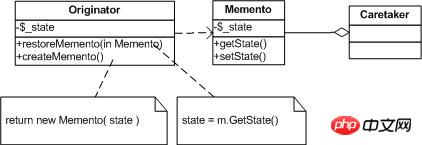
This article mainly introduces the memo mode in PHP design mode, and uses PHP to implement the memo mode. Interested friends can refer to it. I hope to be helpful.
1. Intention
Capture the internal state of an object and save this state outside the object without destroying encapsulation. This allows you to later restore the object's state to its previously saved state.
2. Memo mode structure diagram

3. In memo mode Main roles
#1. Memento role:
Stores the internal state of the originator object, and the originator changes according to needs Determines which internal state of the initiator the memo stores.
The memo can protect its contents from being read by any object other than the originator object.
2. Originator role:
Create a memo object containing the current internal state
Use the memo object to store its internal state
3. Caretaker role:
Responsible for saving the memo object and not checking the content of the memo object
4. Advantages of the memo mode And disadvantages
Advantages of memo mode:
1. Sometimes some internal information of the initiator object must be saved outside the initiator object, but it must be saved by the initiator. Human objects read it themselves.
2. Simplified the Originator class. The Originator no longer needs to manage and save versions of its internal states. Clients can manage the versions of these states they need by themselves
3. When the status of the Originator role changes, it is possible that this If the status is invalid, you can use the temporarily stored memo to restore the status.
Disadvantages of the memo mode:
1. If the status of the initiator role needs to be completely stored in the memo object, the memo object will be very expensive in terms of resource consumption. 2. When the person in charge stores a memo, the person in charge may not know how much storage space this status will occupy, and thus cannot remind the user whether an operation will be expensive.
3. When the status of the initiator role changes, the status may be invalid.
5. Applicable scenarios of memo mode
1. The (partial) state of an object at a certain moment must be saved so that it can be restored to the previous state when needed in the future. state. 2. If an interface is used to allow other objects to directly obtain these states, the implementation details of the object will be exposed and the encapsulation of the object will be destroyed.
6. Memo mode and other modes
1. Command mode (command mode): Command mode can also be used to restore the state of an object. Generally, Command mode can support For multi-level state rollback, Memento is just a simple recovery (snapshot). In each undo of Command mode, Memento can be used to save the state of the object. 2. Iterator mode (Iterator mode): Memos can be used for iteration
7. Memo mode PHP example
<?php
/**
* 发起人(Originator)角色
*/
class Originator {
private $_state;
public function __construct() {
$this->_state = '';
}
/**
* 创建备忘录
* @return Memento 包含当前状态的备忘录对象
*/
public function createMemento() {
return new Memento($this->_state);
}
/**
* 将发起人恢复到备忘录对象记录的状态上
* @param Memento $memento
*/
public function restoreMemento(Memento $memento) {
$this->_state = $memento->getState();
}
public function setState($state) {
$this->_state = $state;
}
public function getState() {
return $this->_state;
}
/**
* 测试用方法,显示状态
*/
public function showState() {
echo "Original Status:", $this->getState(), "<br />";
}
}
/**
* 备忘录(Memento)角色
*/
class Memento {
private $_state;
public function __construct($state) {
$this->setState($state);
}
public function getState() {
return $this->_state;
}
public function setState($state) {
$this->_state = $state;
}
}
/**
* 负责人(Caretaker)角色
*/
class Caretaker {
private $_memento;
public function getMemento() {
return $this->_memento;
}
public function setMemento(Memento $memento) {
$this->_memento = $memento;
}
}
/**
* 客户端
*/
class Client {
/**
* Main program.
*/
public static function main() {
/* 创建目标对象 */
$org = new Originator();
$org->setState('open');
$org->showState();
/* 创建备忘 */
$memento = $org->createMemento();
/* 通过Caretaker保存此备忘 */
$caretaker = new Caretaker();
$caretaker->setMemento($memento);
/* 改变目标对象的状态 */
$org->setState('close');
$org->showState();
/* 还原操作 */
$org->restoreMemento($caretaker->getMemento());
$org->showState();
}
}
Client::main();
?>Related Recommended:
Detailed explanation of bridge mode of PHP design pattern
Proxy of PHP design pattern Detailed explanation of the pattern
Detailed explanation of the strategy pattern of PHP design pattern
The above is the detailed content of Detailed explanation of PHP design pattern memo pattern. For more information, please follow other related articles on the PHP Chinese website!




